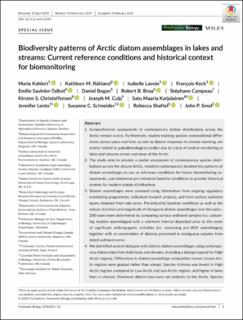Biodiversity patterns of Arctic diatom assemblages in lakes and streams: Current reference conditions and historical context for biomonitoring
Kahlert, Maria; Ruhland, Kathleen M; Lavoie, Isabelle; Keck, Francois; Saulnier-Talbot, Emilie; Bogan, Daniel; Brua, Robert B; Campeau, Stephane; Christoffersen, Kirsten Seestern; Culp, Joseph M; Karjalainen, Satu Maaria; Lento, Jennifer; Schneider, Susanne Claudia; Shaftel, Rebecca; Smol, John P.
Peer reviewed, Journal article
Published version
Permanent lenke
https://hdl.handle.net/11250/2660718Utgivelsesdato
2020Metadata
Vis full innførselSamlinger
- Publikasjoner fra Cristin - NIVA [2147]
- Scientific publications [1172]
Sammendrag
1.Comprehensive assessments of contemporary diatom distributions across the Arctic remain scarce. Furthermore, studies tracking species compositional differences across space and time, as well as diatom responses to climate warming, are mainly limited to paleolimnological studies due to a lack of routine monitoring in lakes and streams across vast areas of the Arctic. 2.The study aims to provide a spatial assessment of contemporary species distributions across the circum‐Arctic, establish contemporary biodiversity patterns of diatom assemblages to use as reference conditions for future biomonitoring assessments, and determine pre‐industrial baseline conditions to provide historical context for modern diatom distributions. 3.Diatom assemblages were assessed using information from ongoing regulatory monitoring programmes, individual research projects, and from surface sediment layers obtained from lake cores. Pre‐industrial baseline conditions as well as the nature, direction and magnitude of changes in diatom assemblages over the past c. 200 years were determined by comparing surface sediment samples (i.e. containing modern assemblages) with a sediment interval deposited prior to the onset of significant anthropogenic activities (i.e. containing pre‐1850 assemblages), together with an examination of diatoms preserved in contiguous samples from dated sediment cores. 4.We identified several biotypes with distinct diatom assemblages using contemporary diatom data from both lakes and streams, including a biotype typical for High Arctic regions. Differences in diatom assemblage composition across circum‐Arctic regions were gradual rather than abrupt. Species richness was lowest in High Arctic regions compared to Low Arctic and sub‐Arctic regions, and higher in lakes than in streams. Dominant diatom taxa were not endemic to the Arctic. Species richness in both lakes and streams reached maximum values between 60°N and 75°N but was highly variable, probably reflecting differences in local and regional environmental factors and possibly sampling effort. 5.We found clear taxon‐specific differences between contemporary and pre‐industrial samples that were often specific to both ecozone and lake depth. Regional patterns of species turnover (β‐diversity) in the past c. 200 years revealed that regions of the Canadian High Arctic and the Hudson Bay Lowlands to the south showed most compositional change, whereas the easternmost regions of the Canadian Arctic changed least. As shown in previous Arctic diatom studies, global warming has already affected these remote high latitude ecosystems. 6.Our results provide reference conditions for future environmental monitoring programmes in the Arctic. Furthermore, diatom taxa identification and harmonisation require improvement, starting with circum‐Arctic intercalibrations. Despite the challenges posed by the remoteness of the Arctic, our study shows the need for routine monitoring programmes that have a wide geographical coverage for both streams and lakes.

